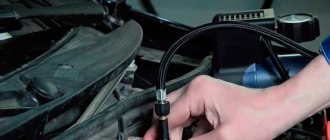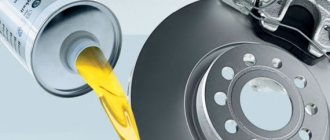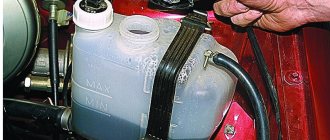When novice motorists come to me for advice on how to best care for their car, I immediately explain two things. If you want to feel safe, then first of all you need to take care of the full operation of the engine and the proper condition of the brake system.
If the engine breaks down, the car simply won’t move, but with the brakes everything is much more complicated. The car will be able to start and even drive all the way, but it will not be possible to brake at the right moment.
Since hardly anyone wants to get into an accident, it’s worth talking not even about filling the brake fluid, but about how much brake fluid is needed to replace the old compound with a new one.
The lack of lubricant in the system will make the brakes inoperable, which will also inevitably lead to an accident. So, this is the topic of my note today, and we will talk about the procedure in more detail later.
Under what circumstances is it necessary to replace the brake fluid?
To understand how much brake fluid may be required to replace consumables in the system, you need to answer one simple question - when does the need for such a procedure arise.
The fact is that many motorists do not read the recommendations in the car service book, although this is necessary. As a result, the driver does not pay attention to obvious signs of deterioration in the condition of the braking system.
The vast majority of motorists follow the old and, in their opinion, proven scheme - they simply top up the brake fluid as needed.
In fact, you can't do that. I advise experienced mechanics in this matter to focus on the indicators on the dashboard, where there is a corresponding symbol. If the level has dropped to a minimum level, then it is time to take serious measures.
Of course, you can simply add fluid, but after this procedure you will need to perform a full check of the serviceability of the brake system.
Brake fluid cannot simply decrease. If the level has decreased, it means that a leak has formed somewhere or a problem has arisen in the operation of the main brake cylinder. It happens that the substance is supplied unevenly to the wheels.
Basic mistakes
- Mix different TJs.
- Do not allow the level to drop below the minimum. That is, to prevent air from entering the system.
- Do not raise the pressure in the tank more than 0.8 atmospheres, otherwise it may explode.
To replace used material with your own hands, you will need to spend a couple of hours of free time on a weekend. The preparation process takes longer. Preliminary preparation will help beginners to be clear and correct in their actions. The main thing is to prevent air from entering the system.
The working cylinders in the vehicle's brake system communicate with the main cylinder through brake fluid. Thanks to their coordinated work, the movement of the master cylinder piston is transmitted to the brake cylinders, and then to the pads. Brake fluid is subject to constant heating, but due to its special composition it does not boil, even if the temperature in the system is above 100 degrees for a long time.
The disadvantage of the composition is its hygroscopicity. Brake fluid is capable of absorbing moisture from the external environment. If it contains more than 3% water, the liquid will lose its effectiveness. If depressurization occurs, air containing vapor that is dangerous to the brake fluid may enter the system. In other words, when air and water enter the system, the boiling point of the brake fluid will drop sharply and at a certain point it will begin to boil.
When boiling, the working volume of the liquid becomes larger and when you press the brake pedal, the “excess” liquid is poured into the reserve tank. After cooling, compression occurs and the previously displaced volume may not be enough to create the required pressure in the system. In such cases, the driver feels like the brake pedal falls without resistance, which is very dangerous when driving at high speed. This is why you need to monitor your brake fluid levels and know exactly when to change your brake fluid.
When the safety of car operation is at stake, it is better to turn to professionals. The periodicity of updating the working solution depends both on the manufacturer’s recommendations and on other factors. An experienced auto mechanic will accurately assess the condition of the brake fluid.
Average volume of brake fluid in a car
Replacing fluid in the brake system can be planned, or it can be an emergency. Usually, if repairs to this important part of the car begin, the substance is completely drained. It is highly not recommended to re-fill the TJ into the system, since it has already lost all its working qualities. The optimal solution would be to purchase a new composition.
Many novice drivers are interested in how much brake fluid can be in a regular passenger vehicle. A lot depends on additional equipment (for example, ABS), but usually no more than 550 - 1000 ml. In other words, you don’t need a large container to drain the waste substance.
US standard
The American Department of Transportation has created a quality standard FMVSS No. 116 (Federal Motor Vehicle Safety Standard), which it is advisable to use.
If anyone doesn’t know what DOT is in the designation of brake fluid, then it is nothing more than an abbreviation of the name in English of the US Department of Transportation, that is, Department of Transporation or DOT.
Therefore, owners of new modern cars must adhere to the accepted quality standard, that is, use glycol TJ DOT 4 or glycol-silicone DOT 5.1.
And for old cars, roughly speaking, before the year 2000, you can safely use DOT 3 or BSK.
BSK brake fluid is an old brand of TZh, which is created by combining castor oil and butyl alcohol in a 1:1 ratio. Analogs of BSK liquid: Neva, RosDot, Tom, Rosa.
What does the car need - topping up or completely replacing the brake fluid?
Before proceeding to active actions, the driver should clearly understand what he will do - just longer TJ or he will need to completely change the substance.
The first procedure is simpler, since it is enough to add liquid, and then make sure that there is enough of it for the entire system to fully operate. The second option is more inconvenient, since you will have to completely drain the brake fluid, flush the system and fill in a new compound.
There are several criteria to accurately answer this question, namely:
- the car has already covered 50-60 thousand km on liquid alone;
- The car was used for two to three years.
Actually, these two factors are enough to make a decision to replace the substance. The fact is that over the past time, the TJ has already absorbed a lot of water and has completely or partially lost its technical properties.
An exception may be a situation where the car has been idle for a long time, or has been used too intensively (up to 80-100 thousand km per year). Here only refilling of the substance is possible.
Advice from experienced car owners
We found out how often the brake fluid is changed. Below are some warnings for experienced drivers:
- replace based on the manufacturer's recommendations;
- mix TFs within the same class (it’s better to always use the same one);
- – follow the instructions;
- there should be no H2O;
- if contaminated, prompt replacement is required;
- in a car without ABS, do not allow the fuel fluid level to reach a critically low level when pumping;
- do not create excess pressure in the expansion tank;
- Wipe the tank only with a cloth (water is prohibited).
When deciding to change the solution, take into account the mileage and condition of the car’s brakes. Don't forget the car manufacturer's recommendations. The shelf life of the brake fluid is limited, and it must be renewed.
If you prefer to contact a specialized service station, use Uremont. Here you will quickly find a car service suitable for your location, read reviews from aggregator visitors and receive a response to your application in an average of ten minutes.
Most manufacturers suggest replacing it every two years. On the other hand, as far as distance is concerned, 40,000 kilometers is the milestone after which you will need a replacement. Please remember that each manufacturer has specific requirements that you should read in your user manuals.
What factors influence the need to replace the diesel fuel?
There are a number of other points that may influence the decision to replace. For example, if a driver drives a vehicle too aggressively and prefers a sporty style, then replacing the brake fluid will be required much more often.
The issue is similar with the specification and type of TJ. The better the quality of the product, the longer it will retain its technical parameters. For example, the popular brake fluid DOT 4 is designed for 50-60 thousand km.
Mechanics advise updating such a substance with the specified regularity, or after repairs have been carried out. Much depends on the operating conditions of the car. The more complex the geography, terrain and climate, the shorter the period of use of transport will be. The brake system will also wear out more intensively.
Characteristics of TJ DOT
- Viscosity degree.
- Maximum temperature (boiling).
- Neutral to rubber and plastic products.
- Corrosion resistance.
- The ability to maintain its properties and qualities during long-term operation.
- Ability to act as a lubricant.
- The ability to absorb or not absorb moisture from the air.
According to the American quality standard FMVSS No. 116, brake fluids are divided into 5 classes.
Some are only suitable for disc brakes, others for drum brakes.
A small historical digression
The “pioneers” among brake fluids were substances of mineral origin marked DOT 1 and DOT2, used in cars with a maximum acceleration of up to 60 km/h. But under increased loads, such fuel fluids simply boiled. Their performance characteristics were so unconvincing that they have almost ceased to be used today.
In addition to its main functions, brake fluid of any brand also has positive side effects - lubrication of calipers, oil seals, and cylinders. Only one thing stands out as a disadvantage - the high hygroscopicity of the liquid, which is actually why the fuel fluid has to be changed.
Stages of work
Professionals use a special installation to replace the TJ, but at home you can do without it. The essence of the process is to drain the old substance from each brake caliper through a special fitting, making sure that there is no air in the reservoir. Process steps:
- We look for the cylinder where the brake fluid reservoir is located and remove the cap from it.
- Using a syringe, pump out the old liquid into a plastic bottle.
- Before we fill in a new TZ.
- Jack up the car and remove the wheel.
- Remove the protective cap from the rear fitting valve.
- We put a transparent hose on the fitting, place its other end in a bottle into which the old liquid was drained.
- Loosen the fitting nut with a wrench and quickly return it to the reverse position. When the nut is soured and cannot be touched, it is necessary to knock it down and continue replacing.
- The next step requires an assistant to sit behind the wheel and apply and release the brake several times. 4-5 times will be enough, and the last time you should press all the way and not let go. At this time, at a signal, you need to loosen the nut and after a couple of seconds return it to its original position. Only then can you release the brake pedal.
- It is necessary to perform these manipulations on each wheel 6–7 times, if you have patience, then more is better.
- Check the presence of fluid; when the level is below about 0, add more. At the end, press the pedal again and if it does not sag, then the replacement was successful.
Replacement and pumping
Adviсe:
- Please note that during operations the car must be turned off; to be sure, remove the key from the ignition;
- the bleeding process should begin with the rear left wheel , then move to the right rear wheel, then the left front and front right;
- pump the first fitting until all the old fluid comes out. You can easily distinguish it from a new one by its color. We bleed the other fittings as usual;
- Make sure that the tank is not empty, otherwise you will take in air. When bubbles are noticed when draining the used substance, pump until they disappear altogether.
In what situations do experts recommend bleeding the entire brake system of a car:
- for a large amount of time there is a violation of control (the car suddenly drives in different directions);
- the substance was replaced not at the service center, but independently, by an inexperienced driver;
- pressing the brake pedal, you feel that it is too soft;
- The vehicle's brake system has recently been repaired.
Timely replacement of brake fluid is a very important procedure. Many people don't understand this. Because if you don’t do this, you can simply be left without brakes or without a clutch.
As mentioned, over time, synthetic brake fluid can absorb water. Water can cause corrosion within these systems. Water can freeze in severe frost. Water destroys working and master cylinders, which are not cheap even for a domestic car.
From this we can conclude that it is necessary to change the brake fluid on time and it is better not to skimp on it.
When to replace according to regulations
According to the regulations of many automakers, it is necessary to fill in new brake fluid every 30-60 thousand kilometers. Moreover, the presence of ABS or other additional systems does not affect these indicators. Reduced (15,000 km) replacement period for sports cars. This is due to high speed limits. The time to contact the masters also varies depending on the composition. Glycol-based fluids can be used for no more than two years. They are designed for a range of up to 40,000 km. Silicone ones are more durable. Their service life reaches 5 years. However, these are only theoretical indicators. The main criterion is the change in color of the liquid. If cloudiness or sediment is present, you must immediately contact a car repair shop to completely replace the composition. At service stations, special testers are used to check the condition of the fluid. They determine the percentage of moisture.
Existing types of ABS systems
The sequence of changing ABS brake fluid is essentially a simple and trivial procedure. Despite this, the modern auto industry takes into account safety trends: almost all car models are produced with ASC and EBD systems installed. These components are controlled by the exchange rate stability system - ESP.
In this regard, replacement of TZ is carried out only in authorized service centers. The reason for this lies in the need to connect the ECU to a diagnostic scanner. On those cars in which the valve system and pump with hydraulic accumulator are represented as separate units, it is impossible to change the brake fluid yourself for the same reason.
Our brand
General recommendations in all cases of work when changing the fluid on a car with your own hands:
- Do not allow the chemical to come into contact with your hands, inside the body, or on wires or paintwork;
- it is necessary to use exactly the chemical specified by the manufacturer of the car brand;
- Store leftovers in containers tightly closed.
So, let’s take an example of the operation of replacing the brake fluid on a VAZ 2110 car. We will describe what you need to have on hand below:
How much fluid we need is indicated by the car’s passport. For VAZ 2110 this is 0.55 liters. Let's get started.
- Open the system reservoir.
- We lift the rear of the car, unlock the rear brake pressure regulator - insert a screwdriver between the piston and the plate.
- We release the air release valve of the right rear brake from the rubber cap, insert a hose, the end of which is connected to a container.
- The partner must sharply press the pedal 5 times, and leave it pressed the last time.
- At the same time, we unscrew the valve with a wrench - just make three quarters of a turn, the spent medium should begin to flow out. After the leak stops, tighten the valve, and your partner should not release the pedal until the fitting is tightened.
- It is necessary to add new medium as soon as the tank is empty to the bottom mark. When clear liquid flows out, the operation stops.
- We repeat everything completely on the left front brake mechanism.
- Then we repeat the manipulations again for the second circuit - first we move to the left rear mechanism, and at the end - to the right front.
- We install the caps back, remove the screwdriver from the pressure regulator, and check the efficiency of the system.











